Related Research Articles

Camelot is a legendary castle and court associated with King Arthur. Absent in the early Arthurian material, Camelot first appeared in 12th-century French romances and, since the Lancelot-Grail cycle, eventually came to be described as the fantastic capital of Arthur's realm and a symbol of the Arthurian world.

Lancelot du Lac, also written as Launcelot and other variants, is a character in some versions of Arthurian legend where he is typically depicted as King Arthur's close companion and one of the greatest Knights of the Round Table. In the French-inspired Arthurian chivalric romance tradition, Lancelot is an orphaned son of King Ban of the lost kingdom of Benoic, raised in a fairy realm by the Lady of the Lake. A hero of many battles, quests and tournaments, and famed as a nearly unrivalled swordsman and jouster, Lancelot becomes the lord of the castle Joyous Gard and personal champion of Arthur's wife, Queen Guinevere, despite suffering from frequent and sometimes prolonged fits of madness. But when his adulterous affair with Guinevere is discovered, it causes a civil war that, once exploited by Mordred, brings an end to Arthur's kingdom.

Mordred or Modred is a figure in the legend of King Arthur. The earliest known mention of a possibly historical Medraut is in the Welsh chronicle Annales Cambriae, wherein he and Arthur are ambiguously associated with the Battle of Camlann in a brief entry for the year 537. Medraut's figure seemed to have been regarded positively in the early Welsh tradition and may have been related to that of Arthur's son.
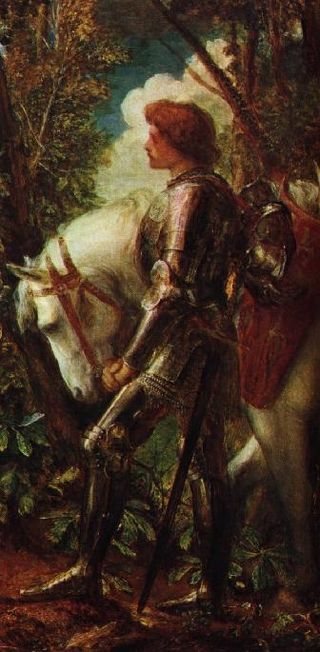
Galahad, sometimes referred to as Galeas or Galath, among other versions of his name, is a knight of King Arthur's Round Table and one of the three achievers of the Holy Grail in Arthurian legend. He is the illegitimate son of Sir Lancelot du Lac and Lady Elaine of Corbenic and is renowned for his gallantry and purity as the most perfect of all knights. Emerging quite late in the medieval Arthurian tradition, Sir Galahad first appears in the Lancelot–Grail cycle, and his story is taken up in later works, such as the Post-Vulgate Cycle, and Sir Thomas Malory's Le Morte d'Arthur.

The Knights of the Round Table are the legendary knights of the fellowship of King Arthur that first appeared in the Matter of Britain literature in the mid-12th century. The Knights are an order dedicated to ensuring the peace of Arthur's kingdom following an early warring period, entrusted in later years to undergo a mystical quest for the Holy Grail. The Round Table at which they meet is a symbol of the equality of its members, who range from sovereign royals to minor nobles.
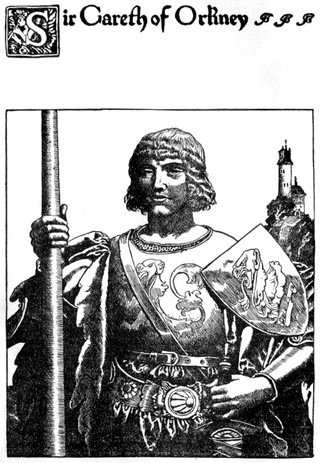
Gareth is a Knight of the Round Table in Arthurian legend. He is the youngest son of King Lot and Queen Morgause, King Arthur's half-sister, thus making him Arthur's nephew, as well as brother to Gawain, Agravain and Gaheris, and either a brother or half-brother of Mordred. Gareth is particularly notable in Le Morte d'Arthur, where one of its eight books is named after and largely dedicated to him, and in which he is also known by his nickname Beaumains.

Elaine is a name shared by several female characters in Arthurian legend, where they can also appear under different names depending on the source. They include Elaine of Astolat and Elaine of Corbenic among others.

Bors is the name of two knights in Arthurian legend, an elder and a younger. The two first appear in the 13th-century Lancelot-Grail romance prose cycle. Bors the Elder is the King of Gaunnes (Gannes/Gaunes/Ganis) during the early period of King Arthur's reign, and is the brother of King Ban of Benoic and the father of Bors the Younger and Lionel. His son Bors the Younger later becomes one of the best Knights of the Round Table and participates in the achievement of the Holy Grail.

Conquests of Camelot: The Search for the Grail is a graphic adventure game released in 1990 by Sierra On-Line. It was the first game in the Conquests series designed by Christy Marx and her husband Peter Ledger. The only other game in the series was 1991's Conquests of the Longbow: The Legend of Robin Hood. Marx did the majority of the design work while Ledger created the game and package art.

Gaheris is a Knight of the Round Table in the chivalric romance tradition of Arthurian legend. A nephew of King Arthur, Gaheris is the third son of Arthur's sister or half-sister Morgause and her husband Lot, King of Orkney and Lothian. He is the younger brother of Gawain and Agravain, the older brother of Gareth, and half-brother of Mordred. His figure may have been originally derived from that of a brother of Gawain in the early Welsh tradition, and then later split into a separate character of another brother, today best known as Gareth. German poetry also described him as Gawain's cousin instead of brother.
Robert de Boron was a French poet active around the late 12th and early 13th centuries, notable as the reputed author of the poems Joseph d'Arimathie and Merlin. Although little is known of Robert apart from the poems he allegedly wrote, these works and subsequent prose redactions of them had a strong influence on later incarnations of the Arthurian legend and its prose cycles, in particular through their Christianisation and redefinition of the previously ambiguous Grail motif and the character of Merlin, as well as vastly increasing the prominence of the latter.
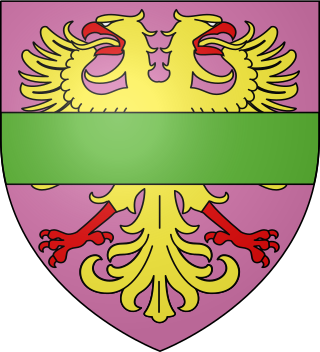
Sir Agravain is a Knight of the Round Table in Arthurian legend, whose first known appearance is in the works of Chrétien de Troyes. He is the second eldest son of King Lot of Orkney with one of King Arthur's sisters known as Anna or Morgause, thus nephew of King Arthur, and brother to Sir Gawain, Gaheris, and Gareth, as well as half-brother to Mordred. Agravain secretly makes attempts on the life of his hated brother Gaheris since the Vulgate Cycle, participates in the slayings of Lamorak and Palamedes in the Post-Vulgate Cycle, and murders Dinadan in the Prose Tristan. In the French prose cycle tradition included in Thomas Malory's Le Morte d'Arthur, together with Mordred, he then plays a leading role by exposing his aunt Guinevere's affair with Lancelot, which leads to his death at Lancelot's hand.

The Lancelot-Grail Cycle, also known as the Vulgate Cycle or the Pseudo-Map Cycle, is an early 13th-century French Arthurian literary cycle consisting of interconnected prose episodes of chivalric romance originally written in Old French. The work of unknown authorship, presenting itself as a chronicle of actual events, retells the legend of King Arthur by focusing on the love affair between Lancelot and Guinevere, the religious quest for the Holy Grail, and the life of Merlin. The highly influential cycle expands on Robert de Boron's "Little Grail Cycle" and the works of Chrétien de Troyes, previously unrelated to each other, by supplementing them with additional details and side stories, as well as lengthy continuations, while tying the entire narrative together into a coherent single tale. Its alternate titles include Philippe Walter's 21st-century edition Le Livre du Graal.
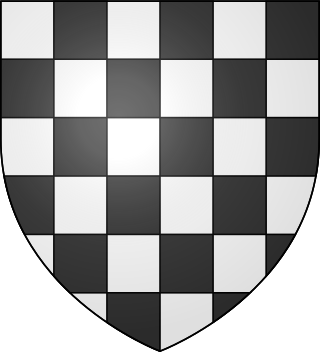
Palamedes is a Knight of the Round Table in the Arthurian legend. He is a Middle Eastern pagan who converts to Christianity later in his life, and his unrequited love for Iseult brings him into frequent conflict with Tristan. Palamedes' father King Esclabor and brothers Safir and Segwarides also join the Round Table. The romance Palamedes was named after him.

Sir Ywain, also known as Yvain and Owain among other spellings, is a Knight of the Round Table in Arthurian legend, wherein he is often the son of King Urien of Gorre and either the enchantress Modron or the sorceress Morgan le Fay. The historical Owain mab Urien, on whom the literary character is based, was the king of Rheged in Great Britain during the late 6th century.

The Post-Vulgate Cycle, also known as the Post-Vulgate Arthuriad, the Post-Vulgate Roman du Graal or the Pseudo-Robert de Boron Cycle, is one of the major Old French prose cycles of Arthurian literature from the early 13th century. It is considered essentially a rewriting of the earlier and more popular Vulgate Cycle, with much left out but also much added, including characters and scenes from the Prose Tristan. The cycle has not survived in any manuscript in its entirety and has been reconstructed from fragments in various languages.
Sarras is a mystical island to which the Holy Grail is brought in the Arthurian legend. In the Lancelot-Grail Cycle, Joseph of Arimathea and his followers visit the island on their way to Britain; while there Joseph's son Josephus is invested as a bishop and shown the mysteries of the Grail by Christ himself. The party wins many converts, and moves on to Britain where they establish a great line of kings. After they achieve the Grail the knights Galahad, Percival, and Bors return the object to Sarras aboard Solomon's ship, but they find the residents fallen back to paganism. The Grail knights restore the people's faith and preside over them benevolently for a year, but Galahad dies in ecstasy when the Grail is taken to Heaven by God, and Percival follows him shortly after. Bors returns to Arthur's kingdom to tell the tale.
Josephus, also called Josephe or Josephes, is the son of Joseph of Arimathea and an early keeper of the Holy Grail in some tellings of the Arthurian legend. He makes appearances in the Quest del Saint Graal section of the Lancelot-Grail cycle, but his story is fully told in the Estoire del Saint Grail, a prequel section written somewhat later. In the Estoire, he is invested as bishop by an apparition of Jesus with the implication that he was the first to receive his orders. Josephus is considered the primary holy man of the group, which is in contrast with the Lancelot-Grail's major source, Robert de Boron's Joseph d'Arimathie, in which his father is the undisputed leader. This is likely due to the authors' assertion that various great families are descended from Joseph; his virtuous son remains chaste and has no children.

Sir Sagramore, also known as Sagramor and other variations of this name, is a knight of the Round Table in Arthurian legend. He appears in many standalone and cyclical chivalric romances and other works, including some where he is the titular protagonist. Sagramore's characterisation varies from story to story, but generally he is characterised as a virtuous but hot-tempered knight who fights fiercely and ragefully.
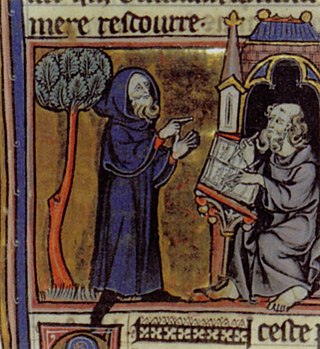
Merlin is a partly lost French epic poem written by Robert de Boron in Old French and dating from either the end of the 12th or beginning of the 13th century. The author reworked Geoffrey of Monmouth's material on the legendary Merlin, emphasising Merlin's power to prophesy and linking him to the Holy Grail. The poem tells of his origin and early life as a redeemed Antichrist, his role in the birth of Arthur, and how Arthur became King of Britain. Merlin's story relates to Robert's two other reputed Grail poems, Joseph d'Arimathie and Perceval. Its motifs became popular in medieval and later Arthuriana, notably the introduction of the sword in the stone, the redefinition of the Grail, and turning the previously peripheral Merlin into a key character in the legend of King Arthur.
References
- ↑ Lacey, Norris J., general ed., Lancelot-Grail: The Old French Arthurian Vulgate and Post-Vulgate in Translation, Vol. 3, pp. 86-87 and note 4.
- ↑ Bruce, Christopher. "Arthurian Name Dictionary: Agrestes". Archived from the original on April 2, 2016. Retrieved April 16, 2012.